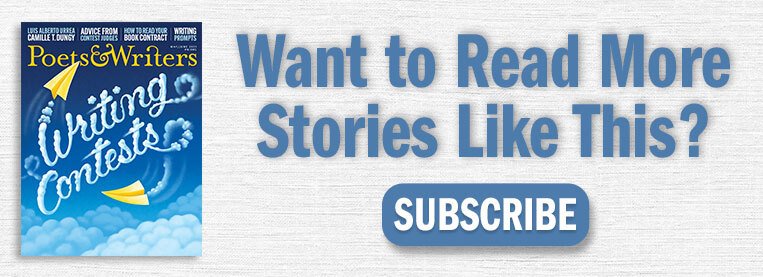This spring the Trump administration walloped the arts community when it slashed federal funding for literary arts and culture, taking major steps to dismantle the National Endowment for the Arts (NEA), the National Endowment for the Humanities (NEH), and the Institute of Museum and Library Services (IMLS). Thousands of organizations nationwide, from large independent publishers to tiny rural libraries, had already budgeted for grant funding when they received word that their grants had been terminated. Though many organizations had already spent the grant money allocated to them, some pending grants were simply revoked. The termination notices embodied the administration’s open hostility toward the arts and humanities and the mounting instability of federal funding many organizations have come to rely on. The government’s sudden reneging also threw institutions that hadn’t yet spent their grants into organizational chaos.
“I’ve come to think of the literary community as an ecosystem—and ours is fragile,” says Daniel Slager, the publisher of Milkweed Editions, a nonprofit publisher that, like most, relies on revenue from book sales, private donations, and government grants. Without support for “keystone species,” as Slager calls independent publishers, literary magazines, arts organizations, event spaces, and the like, this ecosystem will collapse.
While these cuts are crushing to the literary community, eliminating federal grants for the arts is not a significant cost-saving measure, despite claims from the recently created Department of Government Efficiency that state otherwise. For example, the typical annual budget of the NEA costs the average American under eighty cents per year, and the canceled literary awards from this year’s cohort of NEA grant recipients amount to 0.0000002 percent of the 2025 federal budget.
Since the 1960s, when government support for the arts became a federal mandate, the NEA, NEH, and IMLS have had a profound impact on American culture and society, providing thousands of grants annually to recipients in all fifty states. The NEA, established in 1965 by Congress, is an independent federal agency that serves as the largest funder of arts and arts education nationwide, providing support for individuals and organizations in specific disciplines, as well as community-based grants for underserved areas. The NEH, also established in 1965 as an entity separate from the NEA, was the result of a government movement to invest in humanities as well as in science. Like the NEA, the NEH provides grants but to a wider array of fields—historical societies, law archives, museums, and many other cultural institutions that run educational programs and curate exhibitions for the public. The much younger IMLS, established in 1996, ensures access to museums and libraries for all communities. For all three organizations, grantmaking is the primary function, so without the ability to award funding, their missions become essentially impossible to fulfill.
The most outward-facing impact from cuts in funding is reduced programming, which means fewer resources for writers and readers. To take one among thousands of examples: For the nonprofit organization Literary Cleveland, an NEA grant supports its Inkubator Writing Conference, one of the largest free writing conferences in the United States. In 2024 the conference included fifty free events totaling over eighty hours of programming that paid nearly a hundred artists and served more than three thousand people. “It’s a $125,000 program for a national audience that doesn’t happen without NEA money,” says Matt Weinkam, executive director of Literary Cleveland, who predicts the closure of the program without continued NEA funding.
Other setbacks are not as public-facing but have equally harmful effects on the lifeblood of American literary arts. “It’s not just the loss of existing programs,” Weinkam stresses. Grant termination, he says, “discourages the creation of innovative, responsive, or urgent programming we could be creating for the future. With greater uncertainty and less money in the arts ecosystem, organizations are less likely to take risks and try something new.” Slager emphasizes the same point: “If the NEA did not give us any money over the next decade,” he says, “we would publish fewer great books, launch fewer debut authors.”
The rapid and sudden nature of the budget cuts to all three federal agencies has been one of the most notable aspects of the whole situation. To illustrate just how swiftly the cuts have taken effect, consider the timeline for how the IMLS was impacted. On March 14, the Trump administration issued an executive order that reduced the IMLS to its statutory functions, and on March 20, the administration put Keith Sonderling in charge of the organization. By March 31, all IMLS staff were put on “administrative leave.” In early April the National Museum and Library Services Board sent a letter to Sonderling asking questions such as whether there were any staff members left in the IMLS, and the administration summarily fired the board and all remaining IMLS employees—not that there were many left to fire. State library systems in Connecticut, California, and Washington were told that all their IMLS funding had been pulled because their applications were deemed inconsistent with the agency’s new priorities. (Some of this funding has since been restored to Connecticut, but the stability of grant support remains uncertain.)
For many libraries, IMLS cuts mean a direct blow for accessibility. As of this writing, Massachusetts has had to eliminate several disability services, training programs, and prison education efforts. Florida has reduced its “Ask a Librarian” service of virtual reference providers—professionals providing support to Florida residents who need assistance navigating online resources and might not be able to visit a physical library. Washington state closed its Talking Book & Braille Library, a free service for people with a visual, physical, or reading disability that makes them unable to use printed materials. And Idaho has consolidated its Talking Book program with that service in Utah. Micah Bateman, assistant professor of library sciences at the University of Iowa, stressed that, ironically, the libraries hit the hardest by the IMLS budget cuts tend to be small institutions in rural areas that skewed heavily for Donald Trump in the 2024 elections. Whole swaths of rural areas nationwide, for example, rely on IMLS grants for broadband access, which is already disappearing without these funds.
“Every single one of the platforms or digital asset managers that community archives use has been developed using either IMLS or NEH grants or both,” says Bateman. “So no more community or, likely, tribal archives.” Losing the capacity to maintain tribal archives means that documents about under-resourced and sparsely populated Native communities might slip away from the historical archive altogether: Without library funding, future generations might have no record of certain present-day languages and cultures.
Nearly as quickly as the administration has attempted to decimate the IMLS, libraries have fought back. In May, federal Judge John J. McConnell, Jr. ruled in favor of the state attorneys general in Rhode Island v. Trump, in which twenty-one states banded together to sue the Trump administration over the dismantling of the IMLS. And the IMLS has received bipartisan support to maintain operations.
Yet the blows are still only beginning to reverberate nationwide.
“The termination of support is devastating to literary magazines,” says Jennifer Acker, founder and editor in chief of the Common, which was awarded $12,500 in NEA funding in fiscal year 2025, but did not receive the full amount. Grant funding is particularly crucial to newer, growing nonprofits that might not have an established audience to rely on or donors for funding. Many organizations rely on federal funding for daily operations. As Acker says: “Grant funding supports payments to writers and editors, which enables us to publish more writers across all our platforms and retain editors to work with those writers. Grants can also be used to support free community events, like a launch event featuring our writers.” Even if one-time donations and subscription fees might fill in some gaps, relying on ad hoc cash infusions is not a long-term solution.
“The withdrawal of support hit us hard, both symbolically and practically,” echoes Michael Dumanis, editor in chief of the Bennington Review, which was awarded, but never received, $10,000 in NEA funding in fiscal year 2025. Dumanis explains that NEA funds have not only allowed the journal to pay interns and support student workers, but also provided important recognition that annually incentivizes Bennington College, the journal’s home institution, to continue its support of the Bennington Review. In other words the NEA grants can lend organizations a certain amount of legitimacy, without which they might not receive funding from other resources. Without federal funding many organizations lose the ability to do the very thing that makes them stand out in the literary landscape, thus reducing diversity and lowering publications’ capacities to take a risk on unknown authors and champion new voices. Acker says that guest-edited portfolios, a crucial element of the Common that puts international authors in conversation with American writers, rely almost entirely on federal funding.
One of the most perplexing outcomes of the government’s terminating these grants is the uncertainty that this withdrawal causes for future planning. “It’s especially frustrating to be awarded a grant and make complex programmatic and financial decisions contingent on the grant, only to have the grant pulled without significant reason provided,” says Dumanis.
The arts haven’t always received funding from national resources. Slager notes that “it’s not unreasonable to have a national conversation about the role of government in any level of funding in the arts.” But because the current model does rely on the promise of a certain stable level of government support, and has for over fifty years, change needs to come at a reliable pace, so that organizations can make plans. Slager also emphasizes that voters who might be sympathetic to arguments in favor of cutting government bloat “need to understand how limited the rewards to cutting are” and that by cutting these government funds, the organizations that rely on them must retract jobs, a direct hit to the economy. “We have seventeen employees, and they get health insurance, and they have good jobs,” Slager says, but those positions are in peril without NEA grants. Not only are recipients losing funding, but federal employees who administer these grants must also now scramble for jobs.
“On our scale it is real,” says Slager, “and it does [inflict] pain.” But even as government budget cuts have shaken arts organizations and libraries, institutions nationwide are fighting back: Independent funding efforts are on the rise, and ongoing legal actions continue to combat grant terminations. Amid devastating setbacks, as readers and writers continue to mobilize and rally support, the national ecosystem of books and literary culture will continue fighting to adapt and survive.
Update: On August 22, the NEA canceled the 2026 Creative Writing Fellowships program. Writers who had applied were informed by email that their applications were withdrawn and would not be reviewed. Update: On July 24, Judge Colleen McMahon of New York’s Southern District Court ruled in favor of the Authors Guild, finding that the Trump administration’s mass cancellation of NEH grants violated the Constitution and the Administrative Procedures Act. Though the district court could not order that the funds be paid out, Judge McMahon issued a temporary injunction against the Trump administration and ordered that any funds associated with the NEH grants be retained and not re-obligated until a trial on the merits of the case is held. The ruling could still be threatened by further legal action, especially considering the Supreme Court’s decision in late June to limit the use of nationwide injunctions by federal courts.Adrienne Raphel is the author of Our Dark Academia (Rescue Press, 2022), Thinking Inside the Box: Adventures With Crosswords and the Puzzling People Who Can’t Live Without Them (Penguin Press, 2020), and What Was It For (Rescue Press, 2017). She teaches at CUNY and lives in Brooklyn, New York.









